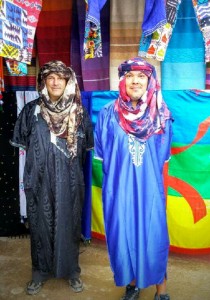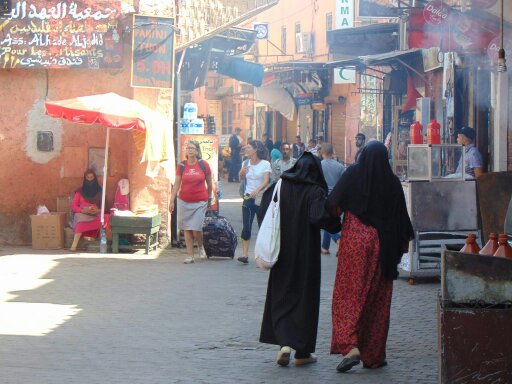Earlier you read about Carter’s Morocco taxi adventures. Today, read all about the beauty of Marrakech, haggling in the Medina and touring through the countryside.
By Carter Hammett
ACT ONE
It’s been almost eight decades since George Orwell wrote about westerners heading for Marrakech in search of “camels, castles, palm trees…brass trays and bandits.” In some respects, not much has changed. “Morocco City”, as tourists once called it, has always been a teeming market place where locals flog their goods and enjoy the pleasures of the night.
The heartbeat of the Arab quarter of town (also called the “Medina”)—since elevated with fine hotels and good restaurants—is without question, the Jemaa el Fna, located in the city’s center. It forms the backdrop for tides of visitors, and just about every snake charmer, ape handler, juggler and musician or combination thereof. A short distance west is the sublime architecture of the Koutoubia Minaret. The public space gradually fills up with everything from tooth pullers to acrobats until it becomes a busker festival of sound and vision. It’s dazzling, if a little overwhelming at first, but gradually you adjust. For a respite, a few rooftop patios offer a retreat-where you can watch the cacophony below.
Red is the dominant color you’ll see in this part of town, which dates back to the Middle Ages. The Medina bursts forth almost as living history with its winding lanes and gorgeous palaces. Meanwhile, the newer part of town is the colonial Ville Nouvelle, built by the French around the middle of the twentieth century. With its ubiquitous patio cafes and chic boulevards, it offers balance in the city.
Perhaps because of its Berber origins, Marrakech became the hub of North African commerce with slaves and gems brought from Timbuktu—“52 days to Timbuktu” is an historic phrase you’ll hear more than once— and helped construct the souks, and mold the behavior of a cultural segment that stands to this day.
 And it’s that behavior you’ll have to get used to. In the ancient souks, caveat emptor is the phrase to keep in mind, as shopkeepers aggressively try to force their wares upon you. Naïve tourists have been known to be lured into a shop and berated into buying something. It doesn’t take long to learn to stand firm as the merchants, perhaps sensing “fresh meat,” go in for the kill. Everywhere I turn, hands attempt to wave me inside the shop. At one point I’m telling them to come out. Here, bargaining is considered an art form and I marvel at theatrics worthy of Noel Coward, as goods and dirhams exchange hands in a contest to see who can avoid being tortured into submission. It’s worth the price of admission.
And it’s that behavior you’ll have to get used to. In the ancient souks, caveat emptor is the phrase to keep in mind, as shopkeepers aggressively try to force their wares upon you. Naïve tourists have been known to be lured into a shop and berated into buying something. It doesn’t take long to learn to stand firm as the merchants, perhaps sensing “fresh meat,” go in for the kill. Everywhere I turn, hands attempt to wave me inside the shop. At one point I’m telling them to come out. Here, bargaining is considered an art form and I marvel at theatrics worthy of Noel Coward, as goods and dirhams exchange hands in a contest to see who can avoid being tortured into submission. It’s worth the price of admission.
Our tour both starts and finishes here. Over the past six days, we’ve been on a journey led by the more-than-capable Brahim El Ouafy, general manager of Nomadic Tours, that’s wound through three valleys, a mountain range rich with stunning views, rejuvenating palmeries, and been blessed with insights into a culture thousands of years old.
“Marrakech for me is where you can go in ten minutes from a new city with new cars and phones, to an old city and experience life in narrow alleyways and get to experience a very diverse society,” says El Ouafy.
Our group of 12—composed of assorted Canadians, British, and Australians—connect immediately. Many have come aboard last minute, and for the next week we’re travelling together. Almost immediately friendships are established, conversations flow and culture absorbed. Our trip takes us through the Drấa and Dades valleys, which are fascinating as much for their lush oases as for the fact that these lands have been in the same families for generations. Fertile grounds measured by their palms and producing figs, almonds, apricots, almonds, barley, mint, tomatoes and carrots are nothing short of remarkable.
I’m greatly moved by the collective effort and communal respect the families seem to have for their generations-old farming and irrigation methods. The farms are kept watered through the cross-pollination of vast underground channels and shared wells. Precious water is distributed evenly to all plots and runs for large distances across the landscape.
After weathering a severe drought in 2015, Morocco adopted an assertive strategy to ensure the resilience of its agriculture economy and conserve natural resources. Part of its strategy is conserving water stored naturally in aquifers. New policies protect the water while ensuring there’s enough to meet farming requirements. Other strategies include lifting subsidies on diesel, gasoline and heavy fuel oil to foster more energy-efficient use. The plan also includes a strategy to protect the livelihoods of its citizens, since farming accounts for 40 percent of the Moroccan workforce.
Don’t forget to check back next week for Morocco: Act Two.




Leave a Reply